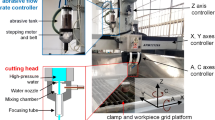Abstract
The article deals with the issues that allow creating conditions that exclude the formation of abrasive agglomerations in the process of applying a polymer coating in installations with a fluidized bed. The authors pay attention to the stages of agglomeration of the abrasive in the fluidized bed, as well as possible situations that arise when one particle collides with another. The problem of agglomeration development in the installation chamber is relevant, as it directly affects the quality of the coating, its uniformity. In addition, the critical size of the agglomerations will stop the coating process and lead to large material losses. The research carried out in the article on the process of obtaining a new effective abrasive material for waterjet cutting makes it possible to increase the cutting capabilities of a waterjet.





Similar content being viewed by others
References
Yang G, Feng B (2020) Orthogonal experiment on the surface quality of carbon fiber reinforced plastic cut by abrasive water jet. Rev Compos Mater Av 30:69–76
Galinovskii AL, Tarasov VA, Elfimov VM (2011) Minimization of the technological cost of waterjet cutting taking into account the cost and technological parameters of the machining process. Izv Vyssh UchZaved Mashinostr 4:46–54
A. F. Salenko, V.T. Shchetinin, A.N (2014) Fedotyevm, Improving accuracy of profile hydro-abrasive cutting of plates of hardmetals and superhard materials, J Superhard Mater, 36(3) 199–207.
Barsukov GV, Zhuravleva TA, Kozhus OG (2020) Water-jet cutting of fiberglass sheet. Russ Eng Res 40(11):963–965
Yang G (2020) Int J Heat Technol 38(2):371–376
Barsukov GV, Zhuravleva TA, Kozhus OG (2018) Methodics of quality of hydroabrasive waterjet cutting machinability assessment, International Conference on Industrial Engineering. Springer, pp 1677–1685
Barsukov GV, Zhuravleva TA, Kozhus OG (2017) Quality of hydroabrasive waterjet cutting machinability. Procedia Eng 2:061,034–061,0611038
Ajmal I, Hashish M (1993) Volume removal trends in abrasive waterjet turning effect of abrasive waterjet parameters. American Society of Mechanical Engineers, Production Engineering Division (Publication) PED
Orel V, Shchetinin V, Salenko A, Yatsyna N (2016) The use of controlled cracking to improve the efficiency of waterjet cutting. East Eur J Enterp Technol
Perec A (2018) Experimental research into alternative abrasive material for the abrasive water-jet cutting of titanium. Int J Adv Manuf Technol 97(1):1529–1540
Miao X, Qiang Z, Wu M, Song L, Ye F (2018) The optimal cutting times of multipass abrasive water jet cutting. Int J Adv Manuf Technol 97(5):1779–1786
Barsukov GV, Zhuravleva TA, Kozhus OG (2017) Increasing of efficiency of environmentally friendly technology of AWJ of a glass fiber plastic. IOP Conf Ser Earth Environ Sci 50(1):012001
Sutowska M, Kapłonek W, Pimenov DY, Gupta MK, Mia M, Sharma S (2020) Influence of variable radius of cutting head trajectory on quality of cutting kerf in the abrasive water jet process for soda–lime glass. Materials 13(19):4277
Momber A (2011) Hydrodemolition of concrete surfaces and reinforced concrete. Elsevier
Perec A, Pude F, Grigoryev A, Kaufeld M, Wegener K (2019) A study of wear on focusing tubes exposed to corundum-based abrasives in the waterjet cutting process. Int J Adv Manuf Technol 104(5):2415–2427
Afanasyeva TA (2009) Optimization of the main chemical-technological processes with parallel side processes//Modern science-intensive technologies. Regional application. - №1
Lykov AV (1978) Heat and mass transfer: a reference book, 2nd edn Rev. and add
Amelin AG (1966) Theoretical foundations of fog formation during vapor condensation. Chemistry, Moscow
Dokhov MP (2006) Calculation of the evaporation time of dispersed particles. Fundamentaln. - No. 10. - S. 66–67
Vitkovsky IV, Frolenkova LY, Shorkin VS (2012) Adhesion-diffusion formation of a multilayer wall of a liquid-metal flow path of a fusion reactor blanket. Tech Phys J 82(7):117
Availability of data and material
Not applicable.
Code availability
Not applicable.
Funding
This research was supported by the Russian Science Foundation, grant no. 20-79-00347.
Author information
Authors and Affiliations
Corresponding author
Ethics declarations
Conflict of interest
The authors declare no competing interests.
Additional information
Publisher’s note
Springer Nature remains neutral with regard to jurisdictional claims in published maps and institutional affiliations.
Rights and permissions
About this article
Cite this article
Kozhus, O., Barsukov, G. The research of the agglomeration process during the formation of an abrasive-polymer compound for waterjet cutting in a fluidized bed installation. Int J Adv Manuf Technol 117, 2511–2518 (2021). https://doi.org/10.1007/s00170-021-07140-0
Received:
Accepted:
Published:
Issue Date:
DOI: https://doi.org/10.1007/s00170-021-07140-0




